Coney Island - Nickel Empire (1920's-1930's)
The completion in 1920 of the subway to New York City, which enabled millions of city's poorer citizens to reach the seaside resort for only five cents, ushered in an era that became known in Coney Island as the "Nickel Empire." It was significant because it transformed the resort by imposing the tastes and financial means of the masses. Where Coney was visited primarily by the rich in the 19th century and later by the middle class, who could both afford the island's food and entertainment, this new group was different and poor.
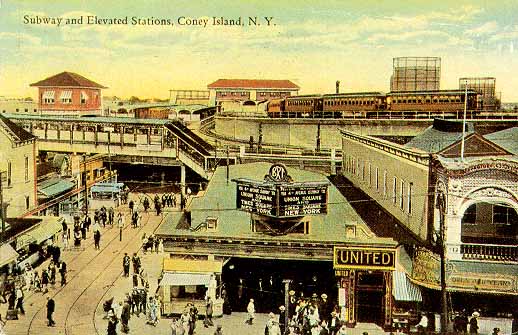
| Coney Island's subway and BMT elevated station opened in 1920. |
They were largely uneducated recent immigrants who worked in New York City's sweatshops for pauper wages and lived with large families in crowded tenements. They came to the seaside with nickels in their pockets, bathing attire beneath their clothes and carrying a basket filled with food. They couldn't afford Coney's bathhouses which charged 50 cents for a room to change clothes, nor could they afford Feltman's ten cent hot dogs. They certainly didn't have 25 cents to waste at a shooting gallery nor the 15 cents to ride a roller coaster or other thrill ride. It wasn't as grim for ride operators as it might appear, especially in the 1920's, for the sheer numbers of visitors to the resort increased dramatically. While the resort attracted 100,000 visitors on summer Sundays in 1900, during the teens it rose to 500,000 people daily. Then when the subway was completed the Island would experience incredible holiday crowds of 1,000,000 sun-starved city dwellers. Fortunately for businessmen the middle class still came to the resort and patronized Luna Park, Steeplechase and the myriad of other attractions and food concessions at the beach.
The second thing that dramatically changed Coney Island was the opening up the beach to the public in 1923. Prior to that nearly all of the beach was privately owned and guarded by barbed wire fences extended deep in the breakers. Visitors, who wanted to use the beach, paid exorbitant prices, a dollar or two, to change in the bathhouse and then use the beach in front. Although many of the establishments advertised 25 cents on weekdays and 50 cents of weekends, in reality they charged what the traffic would bear. Poor families gathered in lines three and four blocks long and waited for hours under the hot sun to snare one of the 12,000 lockers available at the city's Municipal Bath House. Others used grubby residences along side streets where for a dime could change into bathing attire in a room with twenty strangers of the same sex. Then because they walked to the beach in their ill- fitting swim suits without robes, they violated the city ordinance and offended those who they passed. Others, despite the vigilance of the beach patrol, changed briskly on the spot. Discarded clothing from Macy's basement or Kleins littered the beach and fluttered from Coney Island jetties.
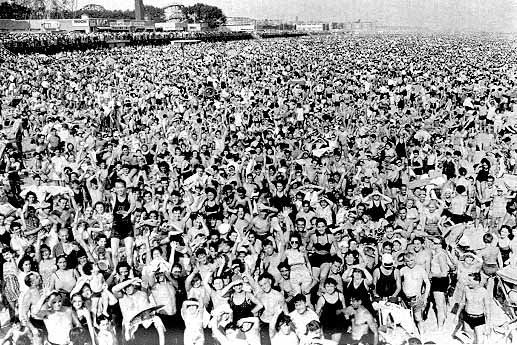
| Coney Island sometimes hosted more than a million people on busy summer Sundays. People were lucky to find enough space to put their towel down - 1940. |
It was the arrival by subway of this mass of humanity that was determined to get on the beach, within their means, by whatever manner that proved most practical that forced the erection of Coney's boardwalk. This $3,000,000 wooden structure, eighty feet wide and half the length of the resort, opened in 1923 and became the ideal promenade for the visitor. As part of the improvement and to combat erosion, groins were built into the ocean and sand was pumped in to create an extra 2,500,000 square feet of beach, free to the public. The sand was tan rather than white because the contractor had saved money by sluicing sand from the wrong place, but the public didn't mind; it was a place to lay in the warm sun. Of course eventually the city fixed the appearance by adding a two inch layer of white sand over the beach's 57 acres in 1941. At the same time they extended the Boardwalk east to Brighton Beach.
In the past it had been the responsibility of each individual bath house, which controlled their own stretch of beach, to provide life saving services for the safety of reckless bathers who often couldn't swim. After the Boardwalk was built the city took over their duties with a professional lifesaving corp. That gradually reduced drownings from about fifty per year, to half a dozen or less. The death toll might have been reduced even further if they could have restricted bathing to only the hours that lifeguards were on duty. However, the public felt that they that had the right to bathe at any time, at their own risk.
The recalcitrant public also supported beach peddlers in their fight against an ordinance making it illegal to sell on the beach. Police would use the elevated Boardwalk to spot peddlers, but the peddlers produced counter-spotters. At a warning signal the peddler would flop to the beach and lie motionless in a carpet of bodies while a nearby bather would toss a stray shirt over the peddler's tray to complete the disguise. Despite the arrest of nearly one hundred peddlers per day, fining them and keeping them in jail overnight, there would be just as many peddlers selling on the beach the following weekend. The bathers were sympathetic to the peddlers because it was more convenient to buy from them than risk losing their spot of beach if they had to frequent one of the food stands erected under the boardwalk.
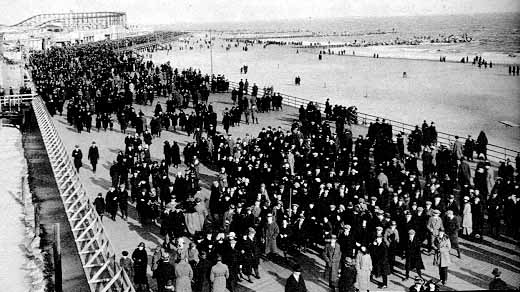
| View of the beach and Boardwalk - 1924 |
Venerable food concessions like Feltman's that charged ten cents for a frankfurter were hurting by the early 1930's. At the height of Coney's boom in the mid 1920's Feltman employed 1200 men to serve 8000 meals at a time in its frankfurter bars, Alpine Gardens and fisheries. They boasted they served 7,000,000 meals in one year and probably grossed over $2,000,000. While they still served the best food on the island and stubbornly stuck to their ten cent price, they lost a lot of customers and their work force dropped to 300.
Meanwhile Nathan's, the first to challenge the ten cent price of frankfurters, prospered with their nickel "red hots." His corner lunch counter, plastered above with a succession of fire engine red signs marked 5 cents, attracted crowds. Fifty employees served customers lined up fifteen deep with the overflow spilling onto Surf Avenue and blocking traffic. In addition to the thousand of frankfurters served every day, they also dispensed hundreds of gallons of root beer, Coca Cola, soda pop and truckloads of potato chips and knishes (Jewish potato cakes flavored with onion and fried in deep fat.)
Paddy Shea's Grisley House originally on the Bowery suffered from a change of customer tastes, too. For years it attracted a middle class crowd mostly of Irish descent who enjoyed a 12 ounce glass well-brewed beer and had an affection for songs and dances of their homeland. When Prohibition and the subway came in 1920, Paddy wouldn't sell liquor illegally. Reduced profits and high rents forced him to move to a new location on Surf Avenue.
The mass of visitors that poured from the subway demanded cheap drinks as well as food. While Shea allowed patrons to bring their own basket lunches, they preferred cheap soft drinks like sarsaparilla and lemon soda. He refused to lower the quality of his drinks or their size and instead trimmed entertainment. Instead of hiring a piano player, he bought a mechanical player piano that played Irish tunes when fed with nickels.
A third change occurred during the winter of 1923-1924 when Surf Avenue and the Bowery were widened for better fire fighting access. The loss of 25 feet of property on each side of Surf Avenue and a similar amount on the Bowery necessitated the tear down of 175 businesses. The narrow walks leading to the beach near the Bowery were widened and thus chopped the Bowery into four short segments. Much of the old Coney Island vanished that winter as venerable old institutions, many operating year round, such as Stubenbord's Restaurant, Stauch's, Henderson's Music Hall, Child's Restaurant and even Nathan's were closed for the first time in memory. Several roller coasters like Drop the Dips and the Red Devil were moved, while others like the Ben Hur Race and Jackman's Thriller were demolished. So were dozens of smaller attractions and rides. Stauch's and Nathan's rebuilt on the same site, while others like Child's Restaurant relocated.
While Coney Island's economy was generally considered recession proof, it did, however, depended primarily on weather. Most of its money was earned during a season only fourteen weekends long. Three rainy weekend could easily have tipped the scales between profit and loss for some and five rainy weekends could bankrupt a concession. Once a Sunday was lost, it couldn't be made up. Concessionaires were forever ready to roll their shutters up or down with the whim of the weather. Summer afternoon thundershowers sometimes came with little warning. For most of Coney Island it meant a bad loss of business, but Steeplechase could earn a moderate profit as thousands, seeking shelter in its huge Pavilion of Fun, paid fifty cents for the privilege.
The nickels in the masses' pockets became the symbol of a new era. The mass market slowly forced Coney Island's price scales downward. The fifty cent ride became a quarter, quarter rides became fifteen cents, and ten cent rides became a nickel. Shooting galleries were particularly hard hit. For many decades they charged a quarter for fifteen shots, but the masses heading past on the way to the beach rarely took a shot. Proprietors first lowered their prices to fifteen cents, then a dime to attract customers. But if you figured that a rifle load cost five cents and you factored in the rent, the number of galleries was bound to decline from a peak of over twenty as many went belly-up. Some tried less expensive modes of shooting, like water guns, popguns firing cork bullets, or even guns that registered hits via light beams, but the thrill and noise of shooting a real gun vanished.
The crowds wasted millions of nickels and dimes on trashy diversions, particularly those where they could show off or win something. Show offs flocked to the high strikers where, if they were strong or had good timing, could impress a girl. The standard price was two wallops for a nickel, five for a dime. Other diversions involved either rolling or throwing. Skeeball, a carnival version of bowling, was the most popular. Customers put a nickel in a slot for nine balls and bowled down an alley leading to a hump that lofted each ball into the air before it landed in one of the increasingly smaller circles that determined the score. Others opted to throw balls at a pyramid of six bottles and won a cheap prize like a kewpie doll or an armadillo basket if they succeeded in knocking all of them down on the first ball. After the 1929 Depression cheap prizes didn't offer a lure to those who were hard up. Games began to offer coffee, sugar and crackers as prizes because regulations forbid cash prizes.
Freak shows suffered hard times after the Depression. Sam Wagner's World Circus Side Show often drew 20,000 people at ten cents each on a busy Sunday in 1920. By the mid-1930's Wagner was lucky to draw 8000 customers at a dime apiece. With a weekly payroll of $1000 plus another $600 for rent and overhead, a few too many rainy weekends could put the operation in the red for the season. Besides the difficulty of finding new and amazing freaks to interest the apathetic crowds, Commissioner Moses' new regulations banning outside ballyhoo, it became harder for them to draw them inside.
Maybe the shows weren't as good as years earlier, but Wagner still featured Pipo and Zipo, two micro cephalic idiots or pinheads that he dug up in the rural south's cracker country. Then there were the usual staple of freaks; Singing Lotto, Fat Girl, Laurello, the only man with a revolving head, Spider Boy and Professor Graf, Tatoo Artist. Also headlined were acts like Professor Bernard, Magician Extraordinary, and his star act, Bonita and her Fighting Lions.
The Bowery, that narrow congested four block long alley running from Steeplechase to Feltman's Arcade, was still the heart of Coney Island. It was a concentrated distillate of all the midways of all the carnivals in America. It was lined with penny arcades, bars, games booths, food stands and thrill rides. The crowds were thick, the smell of food wafted in the air and the sounds were a combination of mechanical pianos and of a hundred barkers competing with each other for the chance to take the public's nickels.
The Bowery became crowded in the late afternoon when the public was finished with their beach activities Those that had money left in their pockets and a girl by their side usually spent it there. The Bowery's revelry, noise and lights continued to 2 A.M. long after both Steeplechase and Luna closed and turned off their bright lights.
The Golden age of the roller coaster was during the mid-1920's when many of Coney's outdated side friction roller coasters were replaced after the widening of Surf Avenue and the Bowery in the winter of 1923-1924 razed them. Luna's Mile Sky Chaser was the first of the new breed and it featured drops of nearly 80 feet and long length as it surrounded the park on three sides. While Steeplechase debuted The Limit near the Boardwalk the following year, the independent operators were about to unleash a new style of coaster with steep drops and a tight twisting layout on small narrow lots. The Thunderbolt which replaced the Red Devil on the Bowery in 1925 was the first. It was soon followed by Prior and Church's diabolical creation, the Bobs, better known as the Tornado. Then in 1927 Vernon Keenan designed the Cyclone for the Rosenthal Brothers on the old Giant Racer site at Surf Avenue and W. 10th. The $100,000 roller coaster, set in a tight figure eight design and an 86 foot first drop, was a true thrilling ride. Lines for the ride were blocks long and at 25 cents per ride, it returned its investment in a matter of months. It seemed the public, who seemed bored with Coney's coasters after riding in automobiles at 60 MPH, had discovered a new terrifying thrill.
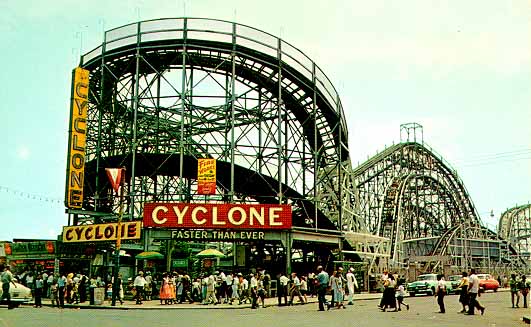
| Cyclone roller coaster at Surf Avenue and W. 10th Street. |
Other independent operators attempted to take advantage of the family trade and set up kiddie parks with miniature versions of adult rides. Still others capitalized on the popularity of bumper car rides slides, fun houses and boat rides. Coney's dozen or more independent carousels were still popular.
But things began to change rapidly once the Depression began. Prices began to fall as middle class customers, who mostly patronized these rides, began losing their jobs. While the Cyclone held their price at 25 cents, the Thunderbolt and Tornado were charging 15 cents and the Wildcat dropped their price to a dime.
Worse, the demand for new rides and attractions quickly evaporated as ride operators could barely pay their rent if they were lucky. Ride manufacturers at Coney Island like Illions ceased production and Mangels operation became a repair only business. The Traver Company in nearby Pennsylvania, supplier of Circle Swings and Tumblebugs, went bankrupt.
Luna Park had trouble attracting patrons to its park, even during the affluent 1920's. While general manager Jarvis had a good feel for updating amusement thrill rides with the latest devices from innovative manufacturers, he had little inkling of what other attractions would capture the public's imagination. He regressed to formulas that worked a dozen years earlier by adding natives inhabiting a Samoan Village, and various girlie shows like Hula, Hula Land and the Charleston Girls. He experimented with cycloramas once again, but those like a slightly updated Trip to the Moon, the Battle of the Marne and Little America during the late 1920's and early 1930's failed to capture the public's imagination because motion pictures were more exciting.
Roller skating, kiddie rides, marionettes and cockroach racing were tried out at Luna Park during the 1930's without much success. Little money was put back into the park. During the 1930 season they reduced the adult gate admission to 10 cents on week days and 20 cents on weekends. Then they tried the 55 cents combination ticket in 1932, but attendance remained light. During some seasons only a fraction of the lights were lit and the rides were looking shabby (shoddy?) and unpainted. The park went bankrupt in May 1933 during the worst of the Depression.
Luna finally opened in the second week of June under receivership. The bankruptcy court decided that since the money had already been spent to refurbish the park for the summer season, the best hope to repay its creditors was to open for the summer season. It rained during its opening weekend and although the weather improved during July and August, the Depression was still on and people didn't have much money to spend on amusements.
While the business outlook at Coney Island began improving by 1935, there were very few new attractions. A Scoota electric boat ride was installed on the Bowery in 1933 and various other operators tried Loop-O-Planes, a Flying Scooter, Boomerang, Octopus and the Lindy Loop. These were all small inexpensive rides that cost only a few thousand dollars at most to own.
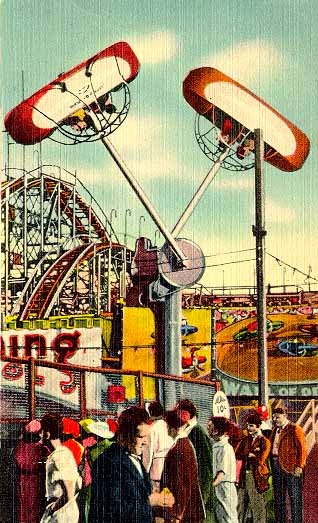
| Loop-O-Plane along the Bowery - 1938 |
Steeplechase was the only park to try a new innovative thrill ride, the Flying Turns. It was a bobsled, and like a roller coaster was a gravity ride where a train of five linked cars on wheels negotiate tightly banked turns inside a long wooden chute. Unfortunately it burned only five years later during the 1939 fire that began under the Boardwalk.
Just as business was beginning to improve in the late 1930's, the two year run of the nearby New York World's Fair competed for Coney's business in the summer of 1939 and 1940. Still there was a bright side in that many of its Midway's best attractions would be moved to Coney Island for the 1941 summer season.
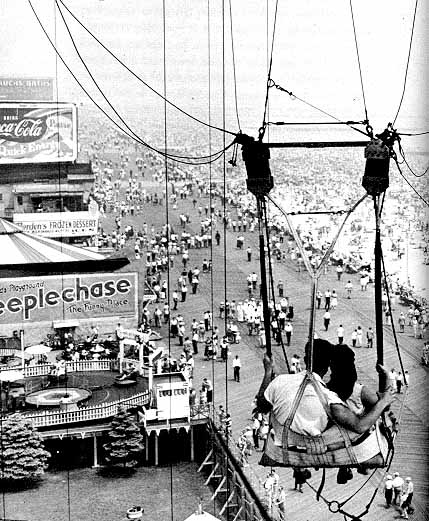
| View of the beach and Boardwalk from Steeplechase's Parachute ride - 1940's |